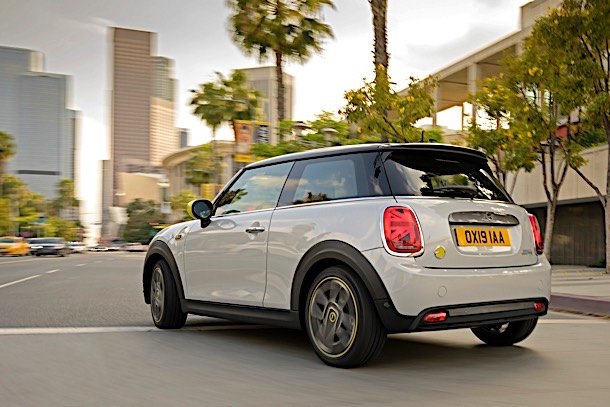Mini Introduces New Cooper SE Electric With Lackluster Range
A few short years ago, there were very few players in the electric vehicle marketplace, with cars like the first-generation Leaf topping out with 73 miles of range. Since then, we’ve seen EVs like the Tesla Model 3 that are rated with 310 miles of range and some models can go even farther between finding a charge point. In this growing and competitive market, Mini introduced an all-new electric Mini, called the Cooper SE.
The Cooper SE is an all electric car with a 135 kW electric motor good for 181 horsepower and 199 lb-ft of torque. Mini doesn’t cite U.S. EPA estimated range numbers, but they are claiming a range of 235 to 270 kilometers. A direct conversion to miles would be — checks notes — 146 miles. Since the European testing cycle is optimistic, the EPA range is likely to sit around 114 miles according to Automotive News.
That’s missing the mark. By a lot.
Maybe it’ll make up for the lack of range by fast charging? Mini says that the Cooper SE will be take advantage of 50 kW fast charging. The Leaf Plus can use a 100 kW fast charger, and Tesla’s later Supercharger stations can pump out the juice at 250 kW. So does it make up for it in charging? No.
Maybe the driving experience will be better in this than other EVs? Mini claims that the Cooper SE is only 319 pounds heavier than the Cooper S with the automatic transmission. On a car this size, that weight would be noticeable if you drove them both back-to-back, but at 3,009 pounds the Cooper SE is still pretty light. Though there aren’t too many people who climb out of a Model 3, especially the Performance version, and think that the experience wasn’t fun.
Mini suggests a 0-60 mph run in 7.3 seconds and a top speed of 93.2 mph. Car and Driver tested a Kona EV and it did the same run in 6.2 seconds (and our first drive proved it to be more sprightly than advertised around town). Nissan’s Leaf Plus has a top speed of 99 mph; the Kona can do 104.
So why choose the Mini Cooper SE over the competition? Because it’s a Mini? Like the bigger, PHEV Countryman SE with an electric range of just 12 miles, the Cooper SE misses the mark on competitiveness. It looks great, especially with the concept’s wheels and the yellow trim pieces, and it’ll surely drive well on a back road. But Minis aren’t usually cheap transportation, making this an expensive city runabout once the brand publishes the official MSRP.
Minis are some of the best driving front-wheel drive cars on the planet, but this one reeks of emissions compliance. Mini is a better car company than this. In this competitive segment they need to do better.
[Images: Mini]
More by Chad Kirchner
Latest Car Reviews
Read moreLatest Product Reviews
Read moreRecent Comments
- Corey Lewis Facing rearwards and typing while in motion. I'll be sick in 4 minutes or less.
- Ajla It's a tricky situation. If public charging is ubiquitous and reliable then range doesn't matter nearly as much. However they likely don't need to be as numerous as fuel pumps because of the home/work charging ability. But then there still might need to be "surge supply" of public chargers for things like holidays. Then there's the idea of chargers with towing accessibility. A lack of visible charging infrastructure might slow the adoption of EVs as well. Having an EV with a 600+ mile range would fix a lot of the above but that option doesn't seem to be economically feasible.
- 28-Cars-Later I'm getting a Knight Rider vibe... or is it more Knightboat?
- 28-Cars-Later "the person would likely be involved in taking the Corvette to the next level with full electrification."Chevrolet sold 37,224 C8s in 2023 starting at $65,895 in North America (no word on other regions) while Porsche sold 40,629 Taycans worldwide starting at $99,400. I imagine per unit Porsche/VAG profit at $100K+ but was far as R&D payback and other sunk costs I cannot say. I remember reading the new C8 platform was designed for hybrids (or something to that effect) so I expect Chevrolet to experiment with different model types but I don't expect Corvette to become the Taycan. If that is the expectation, I think it will ride off into the sunset because GM is that incompetent/impotent. Additional: In ten years outside of wrecks I expect a majority of C8s to still be running and economically roadworthy, I do not expect that of Taycans.
- Tassos Jong-iL Not all martyrs see divinity, but at least you tried.



































Comments
Join the conversation
More range = more potteries = more weight. Within reason, I like lightweight cars more than the heavier versions.
Well, what is Mini going to do when the Honda e comes out? The Honda will be rear wheel drive, have almost the same power (150hp vs. 184hp), more torque (300Nm vs. 270Nm) and has a marginally larger battery (35,5kWh vs. 32,6kWh), and DC charging is double (100kW vs. 50kW). What if the rumours of pricing are true and the Honda e only costs about 30k€ and the Mini 31k€, with the Mini expected to be much more basic equitpment-wise, with customers having to spend about 40k€ for the Mini to be well optioned out vs. the Honda e having the better equipment level at around 35k€? What does speak for the Mini, a lot, is that it has a heat pump as standard equipment which is an absolutely huge advantage for efficiency in most climates for most of the year. While it is possible that the Honda e will also have a heat pump it's very doubtful.